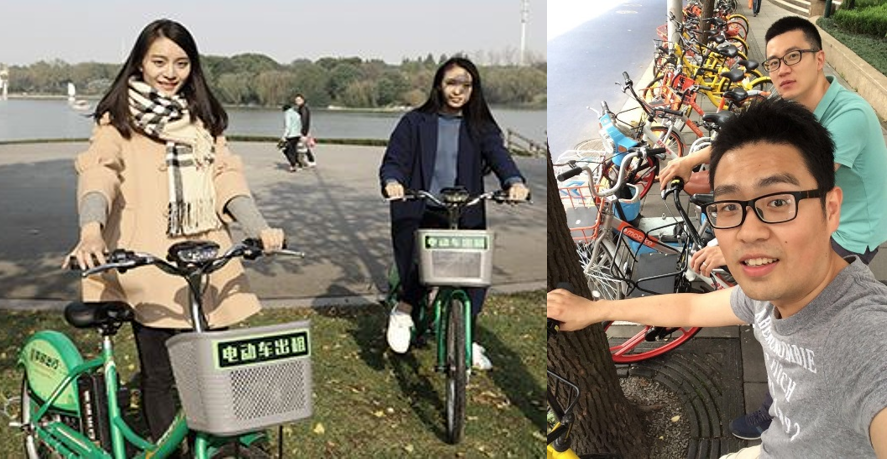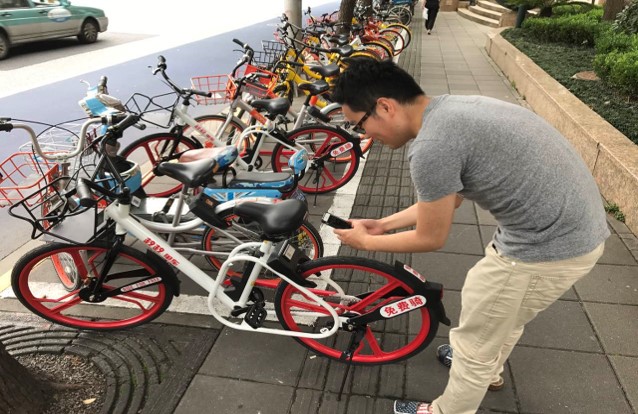China Spotlights
Chinese bicycle boom 3.0
20.07.2017
Mobility in Shanghai: the bike as an alternative to the pitfalls of the Mega City
Chinese cities are currently experiencing a bicycle boom. After bikes had clearly been displaced by cars in recent years, they have been returning to the streetscape for about a year. More and more people are using bicycles again, but most of them are rented.

I (Yiming Chen) myself am the best example: Since late 2016, I have been registered with the e-bike provider Xqchuxing (享骑出行, English: Bike-Fun-Mobility) and have used this service nearly 200 times already. The average distance I cover is 7 km. In total, I have spent about 400 RMB (approx. 50 Euros). But what was it that turned me into a heavy user of rental bikes within such a short period of time?
This has to do with my mobility situation, which is typical of many of Shanghai’s inhabitants.
- Shanghai is certainly the city with the most modern public transport network in China.
- Shanghai is a city of busses: There are 1,545 bus lines with a total length of 25,200 km. In 87% of Shanghai’s city area, there is a bus station every 500 m. (Source: amap.com, 2017 Q1 Major City Transportation Analysis Report)
- But the subway is getting more and more important as well: There are 14 lines with a total length of 617 km and 366 subway stations. The subway transports more than 10 million passengers a day. The construction of 5 new lines and the extension of 4 of the existing lines are planned for the next few years. (Source: baidu baike: Shanghai Metro)
- At the same time, Shanghai, just like other mega cities, has considerable traffic problems (Source: Sina News Shanghai)
- The flood of private passenger cars is growing and growing: Currently, about 3 million private cars are registered in the city, after this figure had increased in 2016 more than ever before: by 360,000 vehicles.
- However, the number of streets is not growing at the same rate: The increase in 2016 was only 2%, and at rush hour, the average speed on downtown main streets is 18 km/h.
Myself, a heavy e-bike user. Why?
But let’s get back to myself and my situation as a road user in Shanghai.
- My wife and I own a Volkswagen Lavida which is mainly used by my wife. She uses it to travel to work every day, about 50km from our apartment in downtown Shanghai. I myself only drive occasionally on weekends.
- My own way to work is very short, as GIM’s Shanghai office is located in the CBD (“Central Business District“) of Shanghai, only 3 km from my apartment, a perfect distance to travel by bike. Compared to the bus or the regular bike, the e-bike is the best solution for me: It only takes me 10 minutes to get to work and costs just 2 RMB (25 Cents) per trip. And of course, the new e-bikes make cycling very comfortable, in stark contrast to the heavy and slow traditional Chinese bikes.
- I am absolutely not a fan of Shanghai’s subway. Most of the time, it is totally overcrowded, and the air is even worse than it usually is in Shanghai.
Private passenger transport services such as Uber or Didi had been very popular since late 2014. However, they are not cheap anymore, because Shanghai’s city government decided in late 2016 to support regular taxis and strongly regulate the private taxi business: Today, only cars of a certain size may participate, and only if both driver and car are registered in Shanghai. This rule eliminated 95% of the cars participating in Uber and Didi. Accordingly, the supply has decreased drastically, and the prices of private services have reached the level of those of regular taxis. (Source: website of the Shanghai city government)
To make a long story short: For me, E-bikes are the best means of transport I can choose in the city in terms of time, cost and my own energy. I have never really thought about this, but if I compare the different options in very concrete terms, it becomes completely clear. Let’s take, for example, a 10 km trip (could be to my parents’ place). If I take the bus, it takes me an hour to get there, costs 4 RMB (50 Cents), and I have to walk 1 km. If I take Didi (which has bought up Uber in the meantime) or a regular cab, it costs 40 RMB (5 Euros) and take 30 minutes. And if I take an e-bike, it costs 2 RMB and takes 45 minutes. Riding a bike may not be everyone’s cup of tea, but on a nice day I prefer it a thousand times over the stuffy subway, even more so if I can ride an e-bike. And this is obviously how many other people in Shanghai feel, as the recent bike rental boom indicates. A study conducted by iiMedia Research confirms my individual impression. The study identifies the three most important reasons why so many people in Chinese big cities rent bikes:
- They are very convenient, as you can find bikes almost anywhere and anytime, and you can return them anytime
- They alleviate the general traffic chaos
- It is cheaper to rent a bike than to own one
And of course, all this is made tremendously easier if you use an app to rent and pay for your bike.

Rental bike providers and their business model
Now I’d like to talk a bit about the two types of bike rentals that exist here in Shanghai. For trips between 3 and 10 km, many people are using e-bikes now. The market leader in the area of e-bikes is Xqchuxing, a provider existing since 2015. Its current situation in Shanghai: a fleet of 60,000 rental e-bikes at 4,000 rental stations, and more than 1 million registered users with an average of 300,000 trips a day. (Netease News)
Using Xqchuxing is simple: You use an app to locate the nearest bike station, unlock the bike by scanning the QR code with your cell-phone, and later you return the bike at one of the stations, simply pressing the return button in your app. The cost is deducted from your account, mostly about 2 RMB per hour. As in most cases, my account is linked to one of the mobile payment apps such as Ali Pay or WeChat Pay.
For trips between 1 and 3 km, people keep using regular bikes, simply because you can get them and leave them at any street corner. These regular bike rentals have recorded an incredible boom in the last two years. In late 2016, there were 28 million registered users, and this figure is expected to reach 200 million by the end of 2017. In March 2017, all providers together had a fleet of more than 4 million bikes all over the country, about 70% of them in the four biggest cities Beijing, Shanghai, Guangzhou and Shenzhen. The two market leaders Mobike and OfO want to conquer other markets quickly, both in China and abroad. In February, Ofo has started its operation in Singapore and already gained 100,000 registered users who take 30,000 trips a day.
The competition between the providers is in full swing by now. All of them focus on introducing as many branded bikes as possible into the market. This also has an interesting effect on the Chinese bicycle industry, which has existed very successfully for 120 years. Currently, the manufacturers don’t have to think about what new designs or technologies they want to launch, but it is the bike rental companies which tell them what to produce.
Disadvantages of the rental boom?
One of the most-discussed disadvantages of the booming bike rental is that children under 12 years of age, who are usually not allowed to ride bikes among motorized traffic, have easy access to bikes now. Some accidents have already happened which deeply moved many people. (Sina news)
On the other hand, the topic of data protection in this context is not an issue at all in China. The users of bike rentals are glad that the providers intensively collect the GPS data of their bikes to optimize their offering in terms of bikes and locations.
Positive opinion of the collection of GPS data
Here in China, nobody thinks that data related to their movements with rental bikes might be used for undesired or even dangerous purposes. If you ask other users, you won’t hear anything about ads synchronized with their bike routes popping up on their cell-phones. Something like that has never happened to me either. On the contrary, many would even appreciate it if they received interesting information about stores along their routes. Yet, at the moment, the providers’ main concern is to optimize their business and assert themselves in the market by optimally distributing as many bikes as possible over the cities, because according to the current business model, the main revenues are the users’ initial deposits amounting to 200-300 RMB (26-39 Euros). And of course, the users choose the provider with the best bike network.
So for us in China, data protection in the context of bike rental is of very low relevance. This is not surprising, as we are used to living in a country where censorship and surveillance are very common.
WeChat for example is a service we all use, even though we all know that it is supervised by the state. The general mindset is: “I am nobody, and I don’t do anything special, so nothing will happen to me.” When it comes to commercial data usage, attitudes are bit more differentiated. It is accepted for big, reputable companies such as Tencent (WeChat), Alibaba, or the big bike rentals like Mobike or Ofo, because we assume that the data are collected for a win-win situation: The companies want to improve their offering and make more money with more satisfied customers. We are only skeptical if the data are collected by smaller companies, because we wonder whether they use their data for illegal activities or purposes which are harmful to the consumers. But altogether, our logic is: Let’s first enjoy the convenience and then think about whether there is a problem with that.


